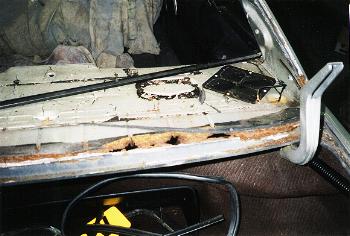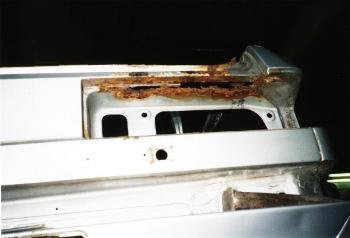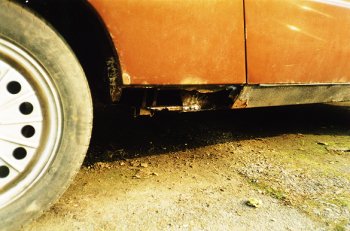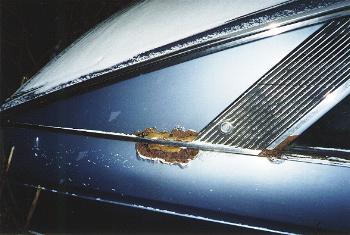 Lancia Gamma Consortium
Lancia Gamma Consortium
|
|
|---|
If you're still not put off the idea of buying a Gamma, bear in mind that, although they can still be bought for relatively little (especially the saloons), the cost and availability of some parts should not be underestimated. There are still quite a few Gammas advertised for sale, so if you fancy one as daily transport, don't be tempted to buy the first one you see.
Check that all the bits that should whirr, click, shine, go up and down, or give a reading do so, and that the trim is in good condition. With most cars, it's the body you need to worry about - engines can always be rebuilt or replaced. With the Gamma it's the other way round. Bodies can be sorted relatively easily, but engines can be a real problem. For more hints on what to look for, read on:
One of the most common Gamma ailments must be head gasket failure, so check that the coolant and oil are where they're supposed to be, and not swapping places with each other. Head gasket replacement is not particularly difficult in itself (it can be done with the engine in the car), but as soon as the heads are removed there is a chance that the cylinder liner bottom seals (paper gaskets between the cast iron liners and the alloy block) may be disturbed. These can only be replaced by withdrawing the liners, which entails removing the pistons etc. The signs of gasket failure are emulsified oil (a milky brown colour) on the dipstick and oil filler cap, oily residues in the expansion tank, and a low coolant level.
Water pumps are not available new, but reconditioned items can be obtained. Badly worn pump bearings will emit a deep rumble and failed seals will cause visible leaks.
Another common problem is cam wear. In severe cases where cam wear is pronounced, performance will drop badly such that a top speed of only 50mph can be achieved. Although the cams cannot be inspected easily, noisy tappets may be an indication of problems here. Despite new cams being unavailable for many years, used ones can be expertly rebuilt and reprofiled. The Gamma Consortium is currently investigating the feasibility of remanufacturing camshafts.
One less common but serious ailment is big end/main bearing wear. The Gamma's habit of mixing anti-freeze mixture with its oil does nothing for lubrication of the crankshaft, so oil pressure should be checked. Although the pressure gauges are not particularly accurate, the reading should be within the centre portion for an engine at about 3000 RPM at working temperature. At idle, however, the pressure reading for a warm engine may drop to almost zero - this is quite normal. Bearings are now in seriously short supply, and the Consortium is currently looking for alternatives.
One of the ironies of the Gamma is that, when compared to other '70s Lancias, bodywork corrosion is relatively minor. Several common problem areas do occur, however, and some are easier to put right than others.

One common trouble spot on the Coupe is at the base of the rear screen. The rear parcel shelf and bootlid rain channel can corrode through here, and repair can only be carried out properly by removing the rear screen. Corrosion here is easily inspected from inside the boot.
Rear wheel arches tend to rust through, so check for filler here and around the lower rear wing, which gets damaged by stone chips.

The rear panel is also a common Coupe corrosion area, around the apertures for the rear lights (see photo) and the bumper.
On early cars, which had no inner front wheelarch liners, both the inner and outer front wings can rot away. In severe cases corrosion can reach the front bulkhead and upper strut mounts. Both front and rear screens are bonded to the bodyshell, and corrosion around the screen trim on both the Coupe and Saloon will mean removing the screen. Unfortunately, this often results in the screen becoming cracked, and although replacements are available, new ones are not cheap!


Both models can suffer sill corrosion, particularly at the joint between the (bolt-on) front wings and the outer sills. New sill panels are not readily available, but the profile is not difficult to copy, especially for the Coupe, and localised repairs are often all that is needed. The floor pan and the rear wheel arches were coated with a PVC layer to prevent stone-chip damage, and these areas tend to be sound.

In general, Saloons tend to fare less well than the Coupe. A particular problem area is caused by the stainless steel trim at waistline level. These are fitted in a recess, and they hold water against the body. Rust usually starts at the trim clip holes and works it's way along from there...
Italian cars are not renowned for the reliability of their electrics, and the Gamma is no exception. The Bosch engine ancillaries (starter motor, alternator, fuel injection) are usually robust, but the minor switchgear and wiring can be troublesome. Make sure that the accessories work, including the electric windows (which are slow at best), the column stalk controls (broken wiper stalks are common), central locking (Series 2 only) and so on.
A few Gammas had leather interior, but the vast majority had cloth trim. This tends to fade and wear, and replacement cloth with the 'L' motif is expensive. On the Coupe, the vinyl headlining tends to sag in the middle, and replacement is very fiddly. This is because it is glued onto a one-piece moulding that can just be removed through one of the doors.
New headlamps have long since been unavailable, especially for the Coupe. Unfortunately, the reflective silvering tends to fail prematurely, and the only solution is to remove the headlamp bowls and have them re-silvered at about £20 each. The difficulty is that the glass lenses must be removed first, and once again they are bonded into place.
Genuine Lancia exhausts are about £700 complete, if you can find one. However, stainless steel replacements are available at considerably less than that (£400-500).
Lancia Gammas are now very rare and don't often come up for sale so it's difficult to give an accurate price guide. In February 2020, Octane magazine gave the following price guide:
Launch price (Coupe): £9186
Excellent: £12,000
Good: £7000
Average: £4000
Project: £1500
Historically the saloons, or Berlinas, were cheaper than the coupes but now are so rare that their values are equal to those of the coupes. As with most classic cars, Gamma prices are on the increase and cars have been advertised in specialist classic car websites and publications for £15,000 or more.
This guide has been produced as an aid to Gamma owners based on the experience of others. Whilst we have tried to ensure that the information given is correct, neither the Gamma Consortium nor any of the contributors towards this guide give any guarantee that the information is free of error and cannot accept any responsibility for the results of following contributor's advice.
Go to the
![]() Next Page
Next Page
|
If you have questions, comments or suggestions about this website, please e-mail gcw@gammaconsortium.com
|